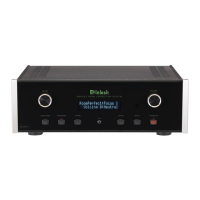19
The “High-Pass” setting allows all the frequencies
above the crossover point to pass on to the Power Am-
plifier while at the same time reducing the amplitude
of the frequencies below the crossover point. Refer
to the separate sheet “Mc 3A” Crossover Curves 4, 5
and 6.
The “Low-Pass” setting allows all the frequencies
below the crossover point to pass on to the Power Am-
plifier while at the same time reducing the amplitude
of the frequencies above the crossover point. Refer
to the separate sheet “Mc 3A” Crossover Curves 1, 2
and 3.
The “Lo-Pas (Low-Pass) Mono” setting is a varia-
tion of the Low-Pass setting and is designed to be
used with a Subwoofer(s). It combines the Left and
Right Channels together into a Mono Signal before the
signal is processed by the MEN220 Crossover Cir-
cuitry. The crossover signal is available at the number
2 Outputs Left and Right.
HIGH AND LOW PASS FILTER SETTINGS:
In the following steps the Crossover Settings will
be set up for a Bi-Amplified System using McIntosh
Loudspeakers. If your Loudspeakers are not McIntosh
contact your Dealer for assitance.
1. Press the MENU Push-button to enter the Setup
Mode. Refer to figure 16.
2. Rotate the NAVIGATE Control (or use the Direc-
tional ▲ ▼ Push-buttons on the Remote Control)
to select “Output Settings”. Refer to figure 24.
3. Press the SELECT Push-button and the “Output
Settings, Crossover Options” will appear. Refer to
figure 25.
CROSSOVER OPTIONS:
1. Press the MENU Push-button to enter the Setup
Mode. Refer to figure 16.
2. Rotate the NAVIGATE Control (or use the use
the Directional ▲ ▼ Push-buttons on the Remote
Control) to select “Output Settings”. Refer to
figure 24.
3. Press the SELECT Push-button and the “Output
Settings, Crossover Options” will appear. Refer to
figure 25.
4. Press the SELECT Push-button and the default
Crossover Setting will appear.
There are four different Crossover Settings for Fre-
quency Response Options; Full Range, High-Pass,
Low-Pass and Lo-Pas (Low-Pass) Mono.
The MEN220 “Full Range” default setting for
both Outputs 1 and Outputs 2 bypasses the built-in
electronic crossover network circuitry. This sends the
entire audio frequency range from 20Hz to 20,000Hz
on to the Power Amplifier. Refer to figures 26, 27,
and 28.
The MEN220 Output Settings include Crossover Op-
tions, Output Levels, Low and High Pass Filters and
Delays Settings. The Low Pass and High Crossover
Curves for both filter types (Butterworth and Link-
witz-Riley) are located on the separate folded sheet
“Mc3A”.
INTRODUCTION TO CROSSOVERS:
Almost all Loudspeakers incorporate acoustic drivers
and a passive crossover network. The passive cross-
over network channels the various audio frequencies
to the appropriate acoustic driver taking into ac-
count the amplitude and phases of the audio signals
the Loudspeaker reproduces. When an electronic
crossover such as the MEN220 is used together with
multiple Power Amplifiers and Loudspeakers, it is
very important to maintain the correct amplitude and
phases of the audio signals for accurate sound repro-
duction.
McIntosh’s Acoustics Laboratory has measured
McIntosh Loudspeakers (with separate Low Fre-
quency/High Frequency connections) when used with
the MEN220 and has arrived at the optimum settings.
There are two different settings. The first setting is for
use with McIntosh Loudspeakers with a Low Frequen-
cy (Woofer) to High Frequency (Midrange/Tweeter)
crossover frequency of 250Hz. The second setting is
when the McIntosh Loudspeaker has a crossover of
80Hz. It is suggested to use these settings.
When the MEN220 is used with non-McIntosh
Loudspeakers it is highly recommended to contact
your Dealer for assistance. Your Dealer has the neces-
sary measurement equipment and knowledge to prop-
erly set up the electronic crossover in the MEN220 for
your Loudspeakers.
Setup, con’t
Output Settings
Figure 24

